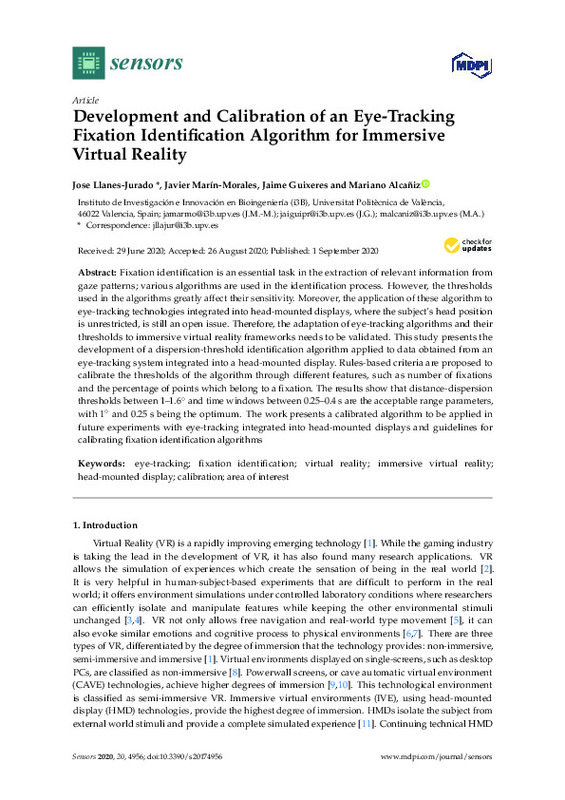Cipresso, P., Giglioli, I. A. C., Raya, M. A., & Riva, G. (2018). The Past, Present, and Future of Virtual and Augmented Reality Research: A Network and Cluster Analysis of the Literature. Frontiers in Psychology, 9. doi:10.3389/fpsyg.2018.02086
Chicchi Giglioli, I. A., Pravettoni, G., Sutil Martín, D. L., Parra, E., & Raya, M. A. (2017). A Novel Integrating Virtual Reality Approach for the Assessment of the Attachment Behavioral System. Frontiers in Psychology, 8. doi:10.3389/fpsyg.2017.00959
Marín-Morales, J., Higuera-Trujillo, J. L., De-Juan-Ripoll, C., Llinares, C., Guixeres, J., Iñarra, S., & Alcañiz, M. (2019). Navigation Comparison between a Real and a Virtual Museum: Time-dependent Differences using a Head Mounted Display. Interacting with Computers, 31(2), 208-220. doi:10.1093/iwc/iwz018
[+]
Cipresso, P., Giglioli, I. A. C., Raya, M. A., & Riva, G. (2018). The Past, Present, and Future of Virtual and Augmented Reality Research: A Network and Cluster Analysis of the Literature. Frontiers in Psychology, 9. doi:10.3389/fpsyg.2018.02086
Chicchi Giglioli, I. A., Pravettoni, G., Sutil Martín, D. L., Parra, E., & Raya, M. A. (2017). A Novel Integrating Virtual Reality Approach for the Assessment of the Attachment Behavioral System. Frontiers in Psychology, 8. doi:10.3389/fpsyg.2017.00959
Marín-Morales, J., Higuera-Trujillo, J. L., De-Juan-Ripoll, C., Llinares, C., Guixeres, J., Iñarra, S., & Alcañiz, M. (2019). Navigation Comparison between a Real and a Virtual Museum: Time-dependent Differences using a Head Mounted Display. Interacting with Computers, 31(2), 208-220. doi:10.1093/iwc/iwz018
Kober, S. E., Kurzmann, J., & Neuper, C. (2012). Cortical correlate of spatial presence in 2D and 3D interactive virtual reality: An EEG study. International Journal of Psychophysiology, 83(3), 365-374. doi:10.1016/j.ijpsycho.2011.12.003
Borrego, A., Latorre, J., Llorens, R., Alcañiz, M., & Noé, E. (2016). Feasibility of a walking virtual reality system for rehabilitation: objective and subjective parameters. Journal of NeuroEngineering and Rehabilitation, 13(1). doi:10.1186/s12984-016-0174-1
Clemente, M., Rodríguez, A., Rey, B., & Alcañiz, M. (2014). Assessment of the influence of navigation control and screen size on the sense of presence in virtual reality using EEG. Expert Systems with Applications, 41(4), 1584-1592. doi:10.1016/j.eswa.2013.08.055
Borrego, A., Latorre, J., Alcañiz, M., & Llorens, R. (2018). Comparison of Oculus Rift and HTC Vive: Feasibility for Virtual Reality-Based Exploration, Navigation, Exergaming, and Rehabilitation. Games for Health Journal, 7(3), 151-156. doi:10.1089/g4h.2017.0114
Jensen, L., & Konradsen, F. (2017). A review of the use of virtual reality head-mounted displays in education and training. Education and Information Technologies, 23(4), 1515-1529. doi:10.1007/s10639-017-9676-0
Jost, T. A., Drewelow, G., Koziol, S., & Rylander, J. (2019). A quantitative method for evaluation of 6 degree of freedom virtual reality systems. Journal of Biomechanics, 97, 109379. doi:10.1016/j.jbiomech.2019.109379
Chandrasekera, T., Fernando, K., & Puig, L. (2019). Effect of Degrees of Freedom on the Sense of Presence Generated by Virtual Reality (VR) Head-Mounted Display Systems: A Case Study on the Use of VR in Early Design Studios. Journal of Educational Technology Systems, 47(4), 513-522. doi:10.1177/0047239518824862
Bălan, O., Moise, G., Moldoveanu, A., Leordeanu, M., & Moldoveanu, F. (2020). An Investigation of Various Machine and Deep Learning Techniques Applied in Automatic Fear Level Detection and Acrophobia Virtual Therapy. Sensors, 20(2), 496. doi:10.3390/s20020496
Armstrong, T., & Olatunji, B. O. (2012). Eye tracking of attention in the affective disorders: A meta-analytic review and synthesis. Clinical Psychology Review, 32(8), 704-723. doi:10.1016/j.cpr.2012.09.004
Rayner, K. (1998). Eye movements in reading and information processing: 20 years of research. Psychological Bulletin, 124(3), 372-422. doi:10.1037/0033-2909.124.3.372
Irwin, D. E. (1992). Memory for position and identity across eye movements. Journal of Experimental Psychology: Learning, Memory, and Cognition, 18(2), 307-317. doi:10.1037/0278-7393.18.2.307
Tanriverdi, V., & Jacob, R. J. K. (2000). Interacting with eye movements in virtual environments. Proceedings of the SIGCHI conference on Human factors in computing systems - CHI ’00. doi:10.1145/332040.332443
Skulmowski, A., Bunge, A., Kaspar, K., & Pipa, G. (2014). Forced-choice decision-making in modified trolley dilemma situations: a virtual reality and eye tracking study. Frontiers in Behavioral Neuroscience, 8. doi:10.3389/fnbeh.2014.00426
Juvrud, J., Gredebäck, G., Åhs, F., Lerin, N., Nyström, P., Kastrati, G., & Rosén, J. (2018). The Immersive Virtual Reality Lab: Possibilities for Remote Experimental Manipulations of Autonomic Activity on a Large Scale. Frontiers in Neuroscience, 12. doi:10.3389/fnins.2018.00305
Hessels, R. S., Niehorster, D. C., Nyström, M., Andersson, R., & Hooge, I. T. C. (2018). Is the eye-movement field confused about fixations and saccades? A survey among 124 researchers. Royal Society Open Science, 5(8), 180502. doi:10.1098/rsos.180502
Diaz, G., Cooper, J., Kit, D., & Hayhoe, M. (2013). Real-time recording and classification of eye movements in an immersive virtual environment. Journal of Vision, 13(12), 5-5. doi:10.1167/13.12.5
Duchowski, A. T., Medlin, E., Gramopadhye, A., Melloy, B., & Nair, S. (2001). Binocular eye tracking in VR for visual inspection training. Proceedings of the ACM symposium on Virtual reality software and technology - VRST ’01. doi:10.1145/505008.505010
Lim, J. Z., Mountstephens, J., & Teo, J. (2020). Emotion Recognition Using Eye-Tracking: Taxonomy, Review and Current Challenges. Sensors, 20(8), 2384. doi:10.3390/s20082384
Manor, B. R., & Gordon, E. (2003). Defining the temporal threshold for ocular fixation in free-viewing visuocognitive tasks. Journal of Neuroscience Methods, 128(1-2), 85-93. doi:10.1016/s0165-0270(03)00151-1
Salvucci, D. D., & Goldberg, J. H. (2000). Identifying fixations and saccades in eye-tracking protocols. Proceedings of the symposium on Eye tracking research & applications - ETRA ’00. doi:10.1145/355017.355028
Duchowski, A., Medlin, E., Cournia, N., Murphy, H., Gramopadhye, A., Nair, S., … Melloy, B. (2002). 3-D eye movement analysis. Behavior Research Methods, Instruments, & Computers, 34(4), 573-591. doi:10.3758/bf03195486
Bobic, V., & Graovac, S. (2016). Development, implementation and evaluation of new eye tracking methodology. 2016 24th Telecommunications Forum (TELFOR). doi:10.1109/telfor.2016.7818800
Sidenmark, L., & Lundström, A. (2019). Gaze behaviour on interacted objects during hand interaction in virtual reality for eye tracking calibration. Proceedings of the 11th ACM Symposium on Eye Tracking Research & Applications. doi:10.1145/3314111.3319815
Alghamdi, N., & Alhalabi, W. (2019). Fixation Detection with Ray-casting in Immersive Virtual Reality. International Journal of Advanced Computer Science and Applications, 10(7). doi:10.14569/ijacsa.2019.0100710
Blignaut, P. (2009). Fixation identification: The optimum threshold for a dispersion algorithm. Attention, Perception, & Psychophysics, 71(4), 881-895. doi:10.3758/app.71.4.881
Shic, F., Scassellati, B., & Chawarska, K. (2008). The incomplete fixation measure. Proceedings of the 2008 symposium on Eye tracking research & applications - ETRA ’08. doi:10.1145/1344471.1344500
Vive Pro Eyehttps://www.vive.com/us/
[-]









